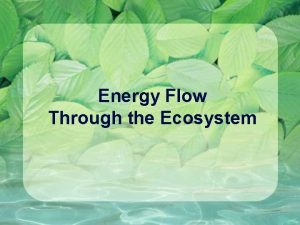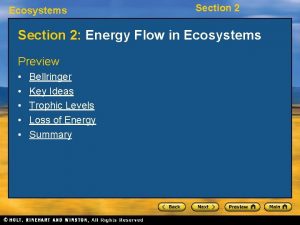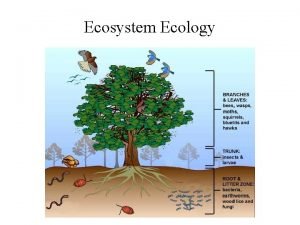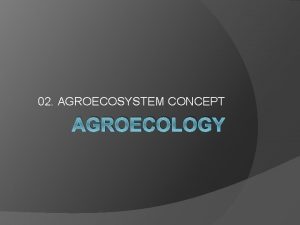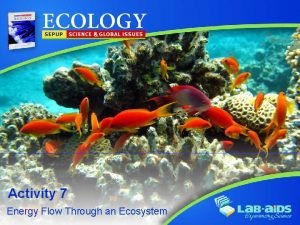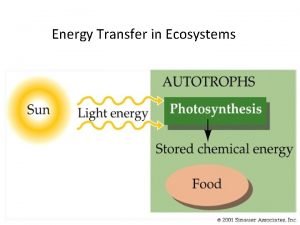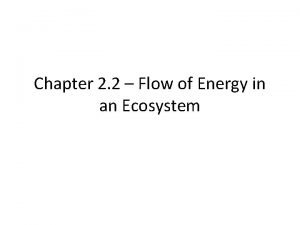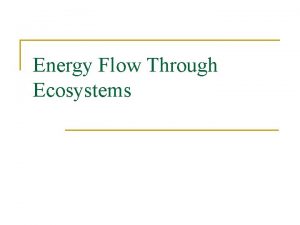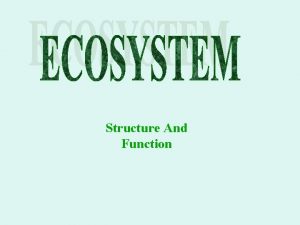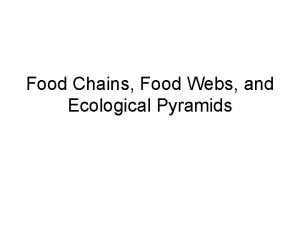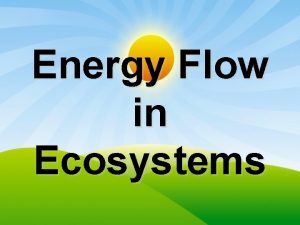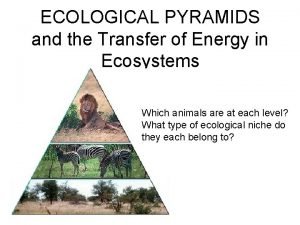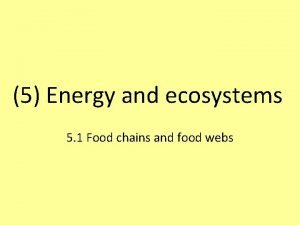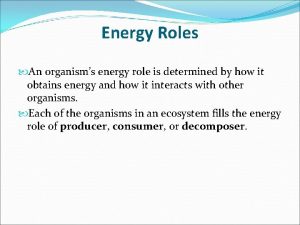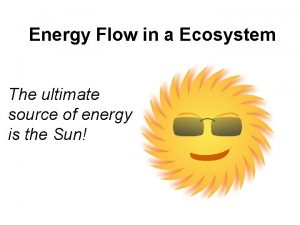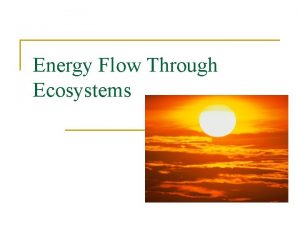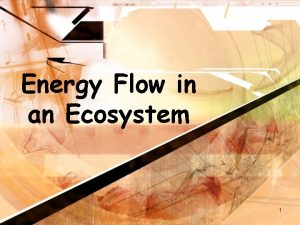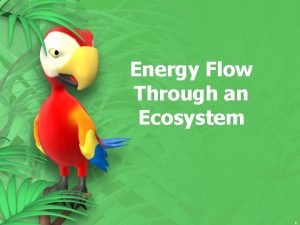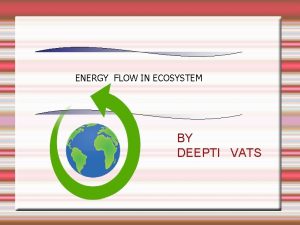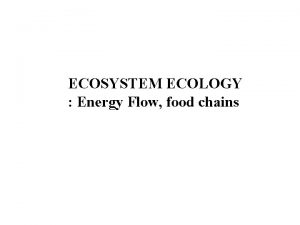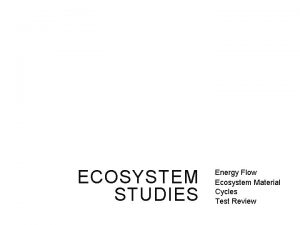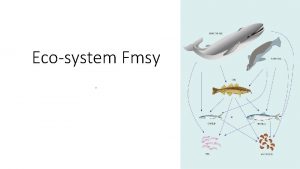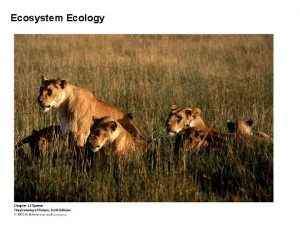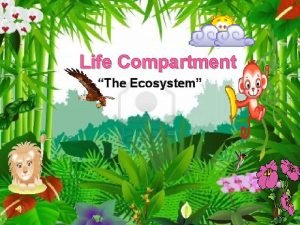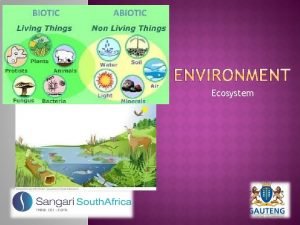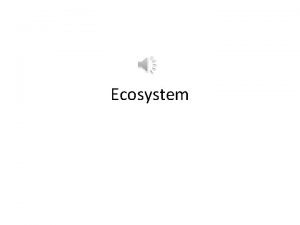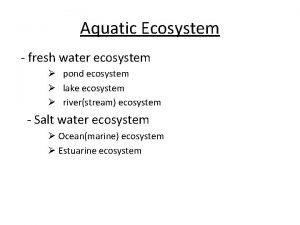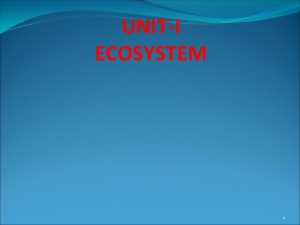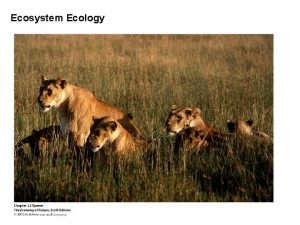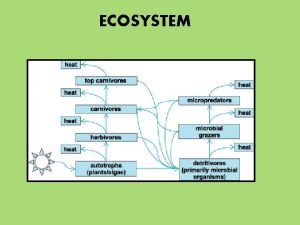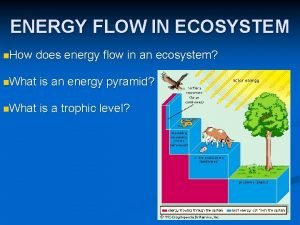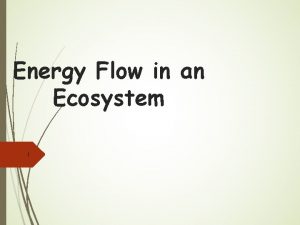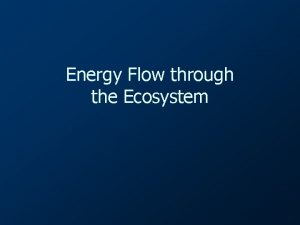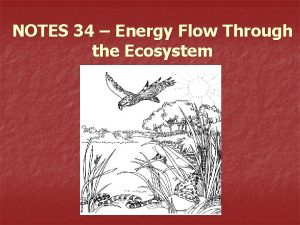Flow of energy in an ecosystem Flow of


























- Slides: 26

Flow of energy in an ecosystem: Flow of energy in an ecosystem takes place through food chain and necessary for the sustenance of an ecosystem. In an ecosystem energy flow is always unidirectional unlike nutrient which moves in a cyclic manner in an ecosystem. The energy flow in an ecosystem follows the law of thermodynamics: 1 st law of thermodynamics: energy can neither be created nor be destroyed but it can be transformed from one form to another. In ecosystem green plant( producers) transform solar energy to biochemical energy which then travels to other trophic level. 2 nd law of thermodynamics: energy dissipates as it is used or in other word it get converted from a more concentrated to dispersed form. In case of food chain also energy dissipate at every trophic level. The main loss of energy takes place through heat and respiration. At every level there is about 90% loss of energy and the energy transferred from one trophic level to another is only 10%. Energy flow model: The flow of energy through various trophic level is given be energy flow models. Some of them are as follows: 1) Universal energy flow model: It is given by E. P. Odum. It explain the flow of energy through an ecosystem, where part of energy is assimilated for the production of biomass and some part get loss due to heat or respiration.

2) Single channel energy flow model: It shows the flow of energy in unidirectional manner through a single channel of green producers to herbivores and carnivores. Example: single channel energy flow model for grazing food chain is given below:


3) Double channel or Y- shaped energy flow model: Combination of grazing and detritus food chain in nature.

Nutrient Cycling: Nutrient cycling is another functional aspect of ecosystem. Nutrient like Carbon, nitrogen, sulphur, phosphate moves in a circular path through biotic and abiotic components and therefore known as biogeochemical cycle. The nutrient too move through food chain and ultimately reach the detritus compartment( containing dead organic matter) where various micro-organism carry out decomposition. In the decomposition process dead organic matter converted into inorganic substances by microbial decomposition which are again used up by plant. carnivores herbivores Producer Organic matter Reuse Inorganic molecule Inorganic substance decomposer Simplified nutrient cycle in ecosystem

Nitrogen cycle:

• The main component of the nitrogen cycle starts with the element nitrogen in the air. • Nitrogen in the air becomes a part of biological matter mostly through the actions of bacteria and algae in a process known as nitrogen fixation. Legume plants such as clover, alfalfa, and soybeans form nodules on the roots where nitrogen fixing bacteria take nitrogen from the air and convert it into ammonium, NH 4. The ammonia is further converted by other bacteria first into nitrite ions, NO 2, and then into nitrate ions, NO 3. Plants utilize the nitrate ions as a nutrient or fertilizer for growth. Nitrogen is incorporate in many amino acids which are further reacted to make proteins. • Ammonia is also made through a synthetic process called the Haber Process. Ammonia may be directly applied to farm fields as fertilizer. Ammonia may be further processed with oxygen to make nitric acid. The reaction of ammonia and nitric acid produces ammonium nitrate which may then be used as a fertilizer. Animal wastes when decomposed also return to the earth as nitrates. • To complete the cycle other bacteria in the soil carry out a process known as denitrification which converts nitrates back to nitrogen gas.

Carbon cycle:

• All living things are made of carbon. Carbon is also a part of the ocean, air, soil and even rocks. • In the atmosphere, carbon is present in form of a gas called carbon dioxide and methane. Trace amount of carbon monoxide is also present. • Plants use carbon dioxide and sunlight to make their own food and grow. The carbon becomes part of the plant and it moves further in other trophic level through food chain. • Plants that die and are buried may turn into fossil fuels made of carbon like coal and oil over millions of years. These fossil fuels are important source of energy for human being. • When humans burn fossil fuels, most of the carbon quickly enters the atmosphere as carbon dioxide. Carbon dioxide acts as green house gas so its increase concentration in atmosphere results into increase earth surface temperature a phenomenon known as global warming. • Ocean is most important sink of atmospheric CO 2 followed by plant biomass.

Oxygen Cycle: The oxygen cycle is the biogeochemical cycle that describes the movement of oxygen within and between its three main reservoirs: the atmosphere (air), the biosphere (living things), and the lithosphere (Earth's crust).

By far the largest reservoir of Earths oxygen is within the silicate and oxide minerals of the crust and mantle (99. 5%). Only a small portion has been released as free oxygen to the biosphere (0. 01%) and atmosphere (0. 36%). The main source of atmospheric oxygen is photosynthesis, which produces sugars and oxygen from carbon dioxide and water: 6 CO 2 + 6 H 2 O + energy → C 6 H 12 O 6 + 6 O 2 An additional source of atmospheric oxygen comes from photolysis, whereby high energy ultraviolet radiation breaks down atmospheric water and nitrous oxides into component atoms. 2 H 2 O + energy → 4 H + O 2 2 N 2 O + energy → 4 N + O 2 The main way oxygen is lost from the atmosphere is via respiration and decay, process in which animal life and bacteria consume oxygen and release carbon dioxide. Chemical weathering of exposed rocks also consumes oxygen. 4 Fe. O + O 2 → 2 Fe 2 O 3

Primary Production: The rate at which radiant energy is converted into organic substances by photosynthesis or chemo-synthesis by the primary producer. It is also known as gross primary production (GPP). Net Primary Production( NPP) : Some part of the organic matter produce during photosynthesis get used during respiration process to produce energy for the sustenance of the primary producer, so the amount of remaining organic matter left is known as Net primary production (NPP). GPP = NPP + R Secondary Production: The plant energy is used up for producing organic matter of the herbivores which, in turn is used up by carnivores. The amount of energy stored by the herbivores or carnivores( in excess of respiratory loss) is known as secondary production. In other word we can say that energy stored at consumer level for use by the next trophic level is known as secondary production.

Wet tropical forest and Estuarine ecosystem are highly productive ecosystem and needed to conserve.

Ecosystem Regulation: All ecosystem regulate and maintain themselves under a set of environmental condition. If there is any stress internal or external applied to the ecosystem it tend to resist the change and maintain itself in equilibrium with the environment due to a property known as homeostasis. Homeostasis is the inherent property of all living system to resist change. However system can show this tolerance only within a maximum and a minimum range, which is its range of tolerance known as homeostatic plateau. Within this range we can have negative feed back mechanisms, these mechanism are counter mechanism against external or internal stress and try to bring the system back to its ideal condition. However if the stress is too high and is beyond the region of homeostatic plateau, then positive feedback mechanism start operating. Positive feed back mechanism add to the stress condition and take the system away form the ideal condition. Example: Increase CO 2 concentration results into increase plant fertility, which in turn result into reduction of atmospheric CO 2. ( Negative feed back mechanism). Due to global warming Ocean temperature increases so reducing the dissolve CO 2 conc. So further increasing the risk of global warming. (Positive feed back)


Ecological Succession: Ecosystems are dynamic in nature and often changes its structure and function due to change in the physical environment or change in the biotic composition. Some of these changes are very orderly and can be predicted. During this change process one type of a biotic community is totally replaced by another type of community over a period of time and this transition continue till a stabilized biotic community sets up. This transition process is known as Ecological Succession. Ecological succession is defined as an orderly process of changes in community structure and function with time mediated through modifications in the physical environment and ultimately culminating in a stabilized ecosystem known as climax. Type of succession: 1) Primary Succession: It start from the primitive substratum, where their was no living matter present before. It is a slow process due to lack of any build up substratum.

Secondary succession: It starts from previously built up substrata where their was presence of living matter before. Due to external factor existing community disappear. These processes are fast. Succession can be autogenic (induced by community itself) or allogenic( due to external factors). Some Definitions: 1) Pioneer community: The first group of organism established in a particular area is known as pioneer community. 2) Seral stages or sere: The whole sequence of communities which are transitory between from Pioneer to climax community are known as Seral stages. 3) Climax community: It is the stabilized community formed in the end of succession process which is in equilibrium with the environment.

Ecological Succession type: Based on the substrata type : 1) Hydrarch or Hydrosere: It start in watery area like, pond, swamp, bog. 2) Mesarch: starting in the area of adequate moisture. 3) Xerarch or Xerosere: Starting in dry area with little moisture. It can be of following type: a) Lithosere: starting on a bare rock b) Psammosere: starting on sand c) Halosere: starting on saline soil.

Process of succession: Succession take place in a systematic order of sequential steps: 1) Nudation: It is development of bare area without any life form. This formation can be due to landslide, volcanic eruption (topographic factor), or due to drought, glaciers ( climatic factor) or due to overgrazing, disease outbreak ( biological factor). 2) Invasion: This is successful establishment of a species in a bare area. It start with migration or dispersal process where seeds, spores reach the bare area through air, water etc. After migration successful establishment of the species( adjustment with the prevailing condition) is know as ecesis. After ecesis , number of species increase in number due to reproduction and come closer to each other a process know as aggregation. 3) Competition and Coaction: As the number of individuals grows there is competition, both inter-specific( between different species) and intraspecific ( within the same species) for space, food and water. Individuals of species affects each other life in various ways and this is known as coaction.

4) Reaction: once the number of species increases, they have a strong influence on the physical environment. The mechanism of the modification of the environment through the influence of living organism in it, is known as reaction. Most of the changes occurs in soil, water, light condition etc. 5) Stabilization: It is the final stage of succession process, where more or less stable community called climax formed which is in equilibrium with the environment. Example of Ecological Succession: 1) Hydrosere (Hydrarch): This type of succession start in a water bodies like pond and culminates in a climax community which is forest. It has following stages: a) Phytoplankton stage: These are the pioneer community. Mainly blue green algae, diatoms and bacteria etc. b) Rooted submerged stage: Due to death and decomposition of phytoplankton organic matter start accumulating on the pond subsurface. This new environment is favorable for the growth of rooted submerged hydrophytes like Hydrilla, Elodea etc.

Hydrosere: different stage of plant growth

3) Rooted submerged stage: Now the depth of lake reduces to 2 -5 feet, favoring the growth of rooted hydrophytes with their large leaves floating on the water surface. Example: Nelumbo, Trapa, Azolla etc. 4) Reed-swamp stage: also known as amphibious stage as the plants of community are rooted but most of it part is in air. Example: Scirpus, Sagittaria etc. 5) Sedge-meadow stage: They form mat like vegetation, results into higher loss of water through evapotranspiration process. The marsh like condition in the previous stage is removed and area with soil moisture left. Example: carex, cyperus etc. 6) Woodland stage: As the marsh land disappear soil become more dry and give rise to vegetation like shrubs( Salix, cornus) and trees ( populus, Alnus). 7) Forest stage: This is climax community. It can developed as tropical rain forest or mixed forest depending upon the climate of the region. Example: Ulmus, Acer and Quercus.

2) Lithosere: A Xerosere on Rock: It start with bare rock and culminate into a forest stage. Different stages of Lithosere as follows: a) Crustose lichen stage: The lichen are the pioneer community. The substratum is very poor in moisture and organic matter, subjected with extreme of temperature. Examples: Rhizocarpon, Rinodina etc. b) Foliose lichens stage: They can absorb more water and retain more water and are able to accumulate dust particle which further help in build up of substratum. Examples: Parmelia, Dermatocapron. c) Moss stage : Xerophytic mosses such as Tortula, Grimmia appears after lichens stage. d) Herbs stage: due to growth of mosses there is more accumulation of soil. This stage is constituted by shallow rooted grasses such as Aristida, Festuca etc which further replaced by shrubs. e) Shrub stage: Species like Rhus, Phytocarpus start growing in the area, which over compete the herbaceous species.

Crustose lichen Foliose lichens Moss

f) Forest stage: This is the climax community for this type of ecological succession. Starting with Xerophytic tree species it changes into mesophytic type and finally into forest type.

Major Ecosystem Type:
 How does energy flow through an ecosystem
How does energy flow through an ecosystem Section 2 flow of energy in an ecosystem
Section 2 flow of energy in an ecosystem Energy flow and material cycling in ecosystem
Energy flow and material cycling in ecosystem Energy flow and material cycling in ecosystem
Energy flow and material cycling in ecosystem Energy flow in ecosystem
Energy flow in ecosystem Describe the flow of energy in the kelp forest ecosystem
Describe the flow of energy in the kelp forest ecosystem Energy transfer in ecosystem
Energy transfer in ecosystem Principles of ecology 2 flow of energy in an ecosystem
Principles of ecology 2 flow of energy in an ecosystem Nutrient chain foldable
Nutrient chain foldable Energy flow through an ecosystem
Energy flow through an ecosystem How does energy flow through an ecosystem
How does energy flow through an ecosystem Ecological succession
Ecological succession Oikos meaning
Oikos meaning Energy energy transfer and general energy analysis
Energy energy transfer and general energy analysis Energy energy transfer and general energy analysis
Energy energy transfer and general energy analysis Deseart animals
Deseart animals Biomass pyramid
Biomass pyramid Abiotic factors examples
Abiotic factors examples Pyramid of biomass in aquatic ecosystem
Pyramid of biomass in aquatic ecosystem Pyramid of number
Pyramid of number Pyramid of energy in ecosystem
Pyramid of energy in ecosystem How does energy enter an ecosystem? *
How does energy enter an ecosystem? * Energy roles
Energy roles Ultimate source of energy in an ecosystem
Ultimate source of energy in an ecosystem Energy flow
Energy flow Rebreathing mask
Rebreathing mask High flow versus low flow oxygen
High flow versus low flow oxygen
